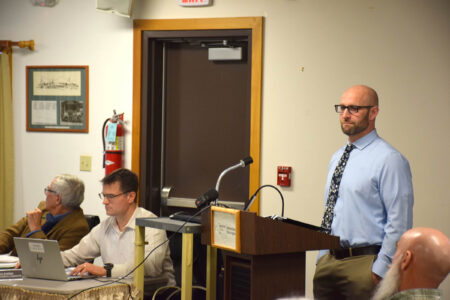‘You don’t know what you’ve got until it’s gone’
Impact of Medicaid cuts to be discussed Sunday
SARANAC LAKE — John Rugge is one of around 250 health professionals and activists who are traveling the North Country, warning people about the impending cuts to Medicaid and the impacts that will have on people’s insurance, their health and the local medical industry as a whole.
The federal cuts to the government-funded insurance program are set to start taking effect as soon as January. The One Big Beautiful Bill Act, which Congress passed in July, plans to cut $1 trillion from Medicaid over the next decade, with the intent of reducing federal taxpayer spending on health care.
Physicians, caregivers and concerned citizens in the non-partisan Healthcare Coalition for the North Country group worry this will cause preventable deaths, hospital closures, human suffering and economic damage.
Using data from the state Department of Health and the Rockefeller Institute of Government, they estimate that 47,600 of the North Country’s 170,000 Medicaid enrollees could lose coverage.
In Franklin County, almost 4,000 are estimated to lose Medicaid coverage. In Essex County, almost 3,000 are projected to lose coverage.
Rugge summarizes the pending cuts by quoting Joni Mitchell.
“You don’t know what you’ve got until it’s gone,” he said.
Rugge — a retired family doctor, founder of Hudson Headwaters Health Network and a state-level policy advisor — will speak about the pending changes with his fellow members of HCNC at an event Sunday at 6:30 p.m., at Adirondack Voters for Change’s new “Community Hub” at 28 Broadway in Saranac Lake. The presentation will also be available via Zoom at tinyurl.com/58rre4f5 or by using meeting ID 850 2871 3492 and passcode 869428.
At the meeting, they also plan to arrange assistance for people facing loss of coverage or an unaffordable rise in insurance costs.
The HCNC has written a “white paper” detailing their concerns with the cuts. The full white paper can be read at tinyurl.com/4zkvaz5r.
The 43-day government shutdown, which ended Wednesday, happened — in part — because Democrats were attempting to get Congress to renew the ACA tax credits and get these Medicaid cuts reversed.
Rugge said many federal legislators believe the taxpayers are paying too much for low-income people to have free or low-cost health insurance. Taxpayers are paying a lot, Rugge said — the cost of health care in America is the highest in the world, but the U.S. ranks the lowest in quality and mortality out of the 32 most developed nations.
North Country Rep. Elise Stefanik was the deciding Republican vote to pass the OBBBA. When asked by the Enterprise about the reason for her vote, a spokesman referenced an article citing a 2024 report from the nonpartisan think tank Empire Center, which analyzed census data that found 3 million New Yorker enrollees “appear to have incomes above the eligibility limits for either Medicaid or the Essential Plan.”
“The figure of $20 billion for fraud, waste and abuse in the NYS Medicaid program cited by some officials is mostly attributable to incomplete documentation or to overestimates of income by recipients for the coming year,” the HCNC paper says.
The paper calls these “correctable errors.”
The bill increases the employment documentation needed to apply for Medicaid to address the alleged widespread fraud. But Rugge said this increases bureaucracy and, he believes, will result in people who would qualify being scared off of applying.
According to the Kaiser Family Foundation, 44% of adults on Medicaid were working full-time and 20% were working part-time. Those who were not working were, in large part, not working due to caregiving (12%), illness or disability (10%) or school attendance (7%). The remaining 8% who were not working include people not working due to retirement or inability to find work.
“Most of Medicaid ‘fraud’ is, in fact, being perpetrated by providers up-coding their encounters and reimbursement rather than by recipients submitting false information,” the paper alleges.
Medicaid needs fixing, Rugge said. It is a bafflingly complex system. He called it “Balkanized” and “commercialized” with a mix of Medicaid, commercial insurance and Medicare. He doesn’t think this is the right way to fix it.
During World War II, companies were not allowed to raise wages, but they could offer insurance benefits. The war ended, but the practice of employer-sponsored health insurance still continues today. He said this contributes to its Balkanization.
Rugge said the federal government could return the federal funding to Medicaid at any time.
–
Local impacts
–
The North Country is the largest and most remote region of the state. It has 608,000 residents and a high percentage of people age 65 or older.
Around 28% of the North Country population is enrolled in Medicaid. This number is estimated to drop from 169,940 to 122,755 by 2034.
These are people on the upper-end of low-income and the lower-end of the middle class. This also impacts people who don’t use Medicaid. They go to hospitals which rely on the revenue.
“HR1 includes the provision of $50 billion over the next five years for the protection of rural Medicaid recipients and services,” the paper states. “While valuable, this funding represents only 0.5% (one half of one percent) of the total cuts mandated by this law, HR1 cuts $137 billion in rural health care.”
Rugge said premiums could start rising as soon as January — an 18% jump in the average rate, according to a report from the KFF. If ACA tax credits expire, the average premium rate could rise by as much as 114%.
Rugge said the majority of the cuts would happen after the November 2026 midterm elections — that’s when documentation requirements kick in.
Medicaid expansions in recent years have allowed the state to expand coverage through its Essential Plan, reducing the uninsured rate to 5%. The state raised the income limit to 250% of the federal poverty level — $39,125 for an individual and $80,375 for a family of four.
The state DOH has already applied to end the Essential Plan by July, returning the income limit to 200% of the federal poverty level — $31,300 for an individual and $64,300 for a family of four. Returning to the Basic Plan will not cover many of the new enrollees — 40% of which are small business owners, employees of small business owners, gig workers and independent contractors — and 450,000 of the 1.7 million people on the Essential plan stand to lose their coverage.
“The uninsured rate in New York State is likely to rise back to 15%, affecting mostly working and middle class people,” the paper states. “With many different names for these programs (Essential Plan, the Marketplace, the Affordable Care Act, Obamacare or Qualified health plans), many enrollees are not aware that they are affected by these cuts.”
–
Hospitals at risk
–
Rugge estimates these changes will create an annual $13 billion loss for hospitals in the state.
The revenue loss in Franklin County is estimated at $12 million next year — an $8.8 million loss in Essex County.
Of the 15 hospitals in the North Country, he said nine have 25 beds or fewer. Several already operate in the red.
Adirondack Medical Center has 39 beds, Elizabethtown Community Hospital has five beds and Alice Hyde Medical Center has 25 beds and 165 long-term care beds.
Alice Hyde and Elizabethtown are both considered at “high risk” of closing.
Rugge said hospitals are pillars of their communities — they are the largest employers, they allow people to live in rural areas because they have access to medical services nearby and they drive economic activity.
Adirondack Medical Center, owned by Adirondack Health, is the largest private employer in the Adirondacks.
According to Adirondack Health CEO Aaron Kramer, 15% of the hospital’s patients get insurance from Medicaid programs, and in the maternity unit, 30% are funded by Medicaid.
“Medicaid covers approximately 50% of childbirths in the North Country,” the paper states.
There are 3,642 nursing home beds in the region. Rugge said the state has not adjusted the nursing homes’ Medicaid reimbursement rate for inflation since 2008 and many are “at the brink of insolvency.”
Medicaid pays for 72% of nursing home days and covers 86% of the at-home care services, he said.
He also said businesses offering health insurance benefits may see unprecedented increases in premium costs — up to 38% in the coming years, on top of their regular inflation increases.
Commercial insurance rates could increase by as much as $1,000 per month, Rugge said.
Commercial health insurance currently costs, on average, around $12,000 annually for an individual and $24,000 for a family of four, he said.
If people can’t afford insurance, he said they tend to forgo preventive care and delay care until it gets severe, when it is more difficult and expensive to treat. It ends up costing more then, he said.
The bill also limits provider taxes. New York taxes providers to help fund its Medicaid program. This tax is funneled back to providers with the help of matching federal dollars, Rugge said.
In every state except New York, the cost of Medicaid is shared between the state and the federal government. New York is the only one where local governments pay a small portion of the state’s share. According to the state Comptroller, Medicaid spending in New York was $101.5 billion in the 2024 fiscal year, of which the federal government paid $57.1 billion (56.2%), the state paid $35.9 billion (35.4%) and localities paid $8.5 billion (8.4%).
Doors for the event on Sunday will open at 6 p.m. with light refreshments provided by Adirondack Voters for Change.
The event will include a questions and answers section.
Contact adirondackvotersforchange@gmail.com or 518-521-5658 for more information.



